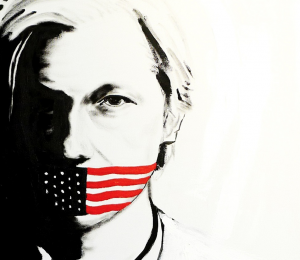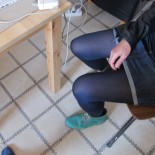«El dibujo del mal»
Texto incluido en el libro de la artista Angie Bonino «Tras las huellas del delito» (2014), presentado en Blue Project julio de 2015.
Borges en su Historia Universal de la Infamia construye las evidencias de que el entramado narrativo que constituye el relato histórico está tejido por hilos filosos: venganzas, recelos, mezquindad. La iniquidad y conspiración parecen fundar un momento inaugural de la modernidad donde el humanismo y los ideales libertarios parecen sólo una pantalla, un ejercicio cosmético cuyo maquillaje precario se descorre rápidamente. La constatación de Thomas Hobbes afirmando que «el hombre es el lobo del hombre» podría operar como epígrafe de la civilización occidental de los últimos siglos. La banalidad del mal se expande y contrae en círculos concéntricos que van desde las cúpulas políticas, las mafias, los litigios económicos hasta la violencia doméstica, laboral o de barrio. Nada de esto es nuevo.
Lo excepcional de nuestros tiempos tal vez sea el descaro con que el mal se representa. La información, como nunca en la historia, se ha hecho accesible -por lo menos una parte de ella-, pero a la vez deviene en fábula, caricatura perversa.
Al mismo tiempo, los aparatos de contra-información se multiplican a pesar de las barreras de control y vigilancia de las redes sociales. ¿Esto nos libera del mal? Quizás tampoco, aún cuando la sospecha se ha vuelto un tic cotidiano; para muchos un pasatiempo masoquista y para otros un oficio rentable. Sospechamos del poderoso, pero también del delator; despreciamos al ignorante, pero a la vez nos cansa el suspicaz que anda viendo teorías de la conspiración tras el brillo hipnóticamente bello y bobo de nuestros smartphones y tablets.
Quizás contra ello, Bonino, en un ejercicio de una honestidad tremenda, actualiza la sospecha y la representación del mal desde la intimidad y cercanía de la materialidad básica del oficio de artista: el lápiz, el papel, la tinta, la pintura se vuelven los ingredientes con los cuales convierte en estampas icónicas lo que la prensa banaliza. Pero además, vincula este arte rescatando el dibujo como práctica artesanal de documentación policíaca. Acompaña la ilustración monocroma similar a la ejecutada en los juicios orales -que bien conocemos por los filmes policíacos- con el trazado de diagramas y mapas conceptuales que permiten el desarrollo de investigaciones criminales.
Desde su obra videográfica, ahora trasladada a la bidimensionalidad de la cartulina y la tela, convoca atemporalmente el espíritu de denuncia que animó el trabajo de los primeros artistas modernos del siglo XX que veían en la práctica artística algo más que un ejercicio solipsista, contemplativo, decorativo o metalinguístico. Sus dibujos y diagramas son una manera ritual y crítica de implicación social, de interferencia y concientización social acerca de los meandros del mal de hoy y los límites entre ficción y delito.
English Version
Borges in his Universal History of infamy creates the evidence that the narrative plot that constitutes the historical story is a mix of woven yarns: revenge, mistrust, and miserliness. Iniquity and conspiracy seem to form an inaugural moment of modernity where humanism and libertarian ideals seem to be just a screen, a cosmetic exercise whose precarious make-up occurs quickly. Thomas Hobbes statement affirms that ”man is wolf to man” could work as an epigraph of Western civilizations of last centuries. The banality of evil expands and contracts in concentric circles ranging from political leaders, mafias, economic disputes to labour, domestic violence or neighbourhood. None of this is new.
What is exceptional about our time is perhaps the effrontery with which evil is represented. Information, as ever in history, became accessible – at least a part of it-, but at the same time turned into fable, and perverse caricature.
At the same time, counter-information devices are multiplying despite barriers of control or supervision of social networks. Would that set us free from evil? Perhaps not, although suspicion has become an every day obsession; for lots of people like a masochist pastime, for others like a profitable business. We suspect the powerful, but also the informer; We despise the ignorant, but at the same time we get tired of the mistrustful, who go on reading the latest conspiracy theories that appear through the beautiful and hypnotic displays of our smartphones and tablets.
Perhaps against it Bonino, with an exercise of a tremendous honesty would update the suspicion and the representation of evil from the intimacy and closeness of the basic materiality of artistic works: pencil, paper, ink, and paint are the ingredients to convert into iconic prints which the press banalises. On the other hand, she also connects this kind of art rescuing drawing as a craft practice of police documents. This accompanies the monochrome artwork, similar to the oral proceedings of executions – that we all know from the police movies – with the layout of diagrams and conceptual maps that allow the development of criminal investigations.
From her video works, now transferred to the bi-dimensionality of cardboard and fabric, timelessly evokes the spirit of denunciation that encouraged the work of the first modern artists of the twentieth century who saw artistic practice as something more, than just a solipsistic exercise, contemplative, decorative or metalinguistic. Her drawings and diagrams represent in a kind of critical and ritualistic way the social involvement, interference and social awareness of meanders of the evil of today and boundaries between fiction and crime.



